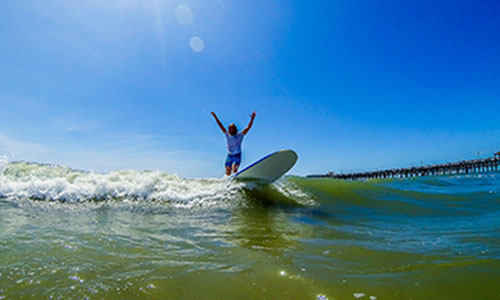
Myrtle Beach locals and longtime visitors know the best amusement ride in town is free, and one takes off every 10 seconds or so. We're talking, of course, about riding the waves of the Atlantic Ocean via the popular pastime of surfing.
The Grand Strand, the 60-mile stretch of Carolina coastline that surrounds Myrtle Beach, isn't famous for the monster waves of the Outer Banks, which makes it the perfect place for newbies to learn how to surf. Depending on the wind, tide and wave action, Myrtle Beach offers excellent surf conditions, a safe, sandy bottom, and lots of locations to hang 10.
There's something about standing atop a board and riding on the water that hooks new surfers. After the first time you pop out of the water and up on the board, you may spend the rest of the day trying to recapture that feeling. For guests at The Caribbean Resort & Villas who want to learn how to surf, and for those who have already been bitten by the surf bug, here are a few things you need to know to navigate the local waters:
* Surf Zones: As a safety precaution to avoid potential run-ins between surfers and swimmers, the City of Myrtle Beach has established surf zones, or stretches of beach where surfing is permitted. Guests at The Caribbean are fortunate to be a few blocks from some of the most popular surf zones in town, including the nearby Golden Mile (from 34th Avenue North to 47th Avenue North). Known by locals as a surfing hot spot, this span is open for surfing during prime hours (from 10 a.m. to 5 p.m.). Other zones in the city limits include the area around Springmaid Pier, from 62nd to 68th Avenue North, and from 87th Avenue North to north city limits. Surfers are generally eager to share their love of the sport with newbies and are often helpful in getting them started.
* Learning to Surf: Surfing is a sport you can enjoy even when you are just learning how to do it. Even if your day is spent falling off your board, you’ll get a good workout and have a nice time playing in the waves. Experts recommend spending time practicing your moves on dry land before you ever set foot in the water. Place your board on the sand and assume the down push-up position atop it. Practice popping up to the standing position in one fluid motion, with one foot forward and the other foot back. Most right-handed/footed folks place their right foot in back for stability and steering and their left foot forward for balance. Left-handed/footed individuals, or “goofy-footers,” typically use the opposite stance. Once you've mastered the move, paddle out past the breakers and get comfortable on the board before you try to catch your first wave. Position yourself ahead of the breakers and attempt to paddle into the sweet spot, timing your stand with the beginning of the wave barrel. Don't get discouraged. Most people struggle at first and learn by trial and error.
* What You’ll Need: Another beauty of surfing is that you really only need two things to do it — a board and a wave. The Atlantic Ocean provides the latter, but the former can be a bit trickier. If you have your own board, you’re all set, but most first-timers need to buy, borrow or rent a board. We recommend first-timers rent a board through one of the many local surf shops, and there are surf lessons available that include use of the board. There’s no need to rush out and buy a brand-new board if you are only able to use it for a week while you are visiting the beach. Newbies will find it easier to learn how to surf on a longboard, which are more buoyant and stable than the shorter models.
After a long, fun day of riding the waves, head back down the beach to your cozy room at The Caribbean Resort & Villas for a relaxing dip in the hot tub or a nice nap on your private balcony. Your newfound surfing muscles might ache, but there will be a smile on your face.

